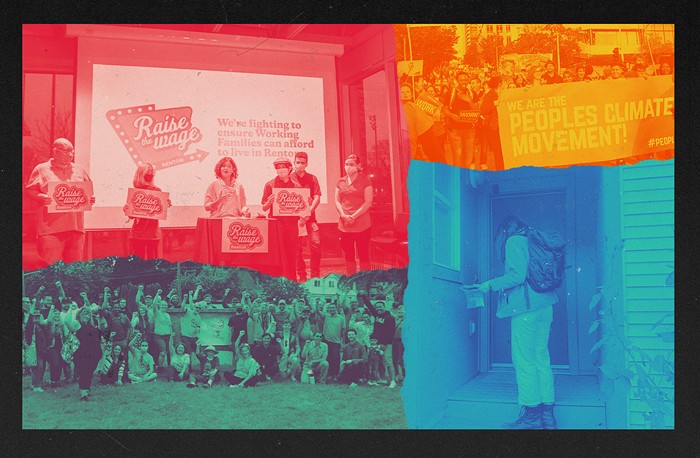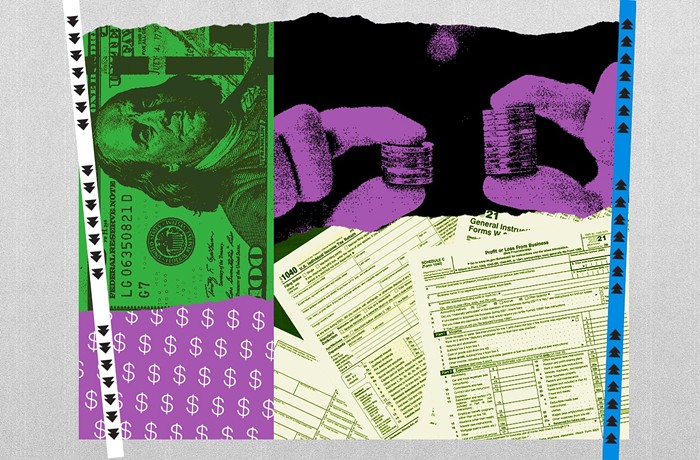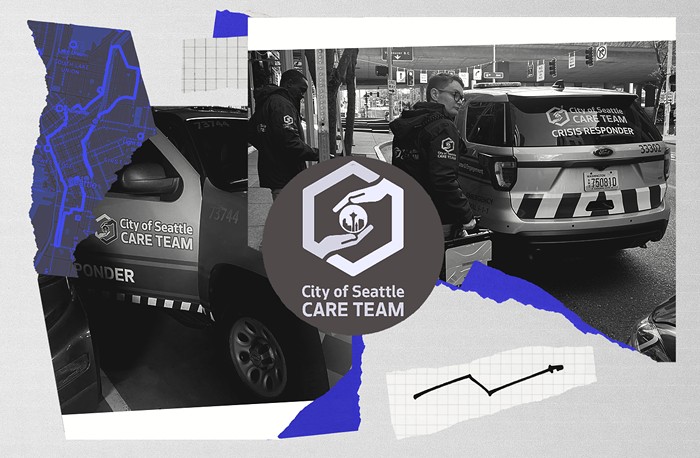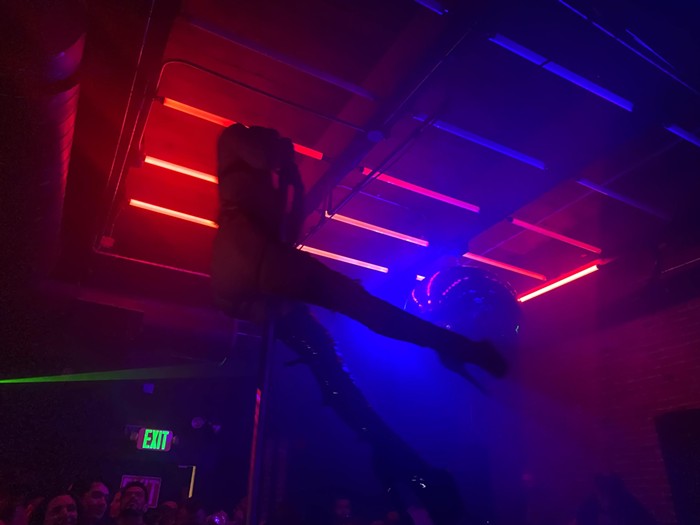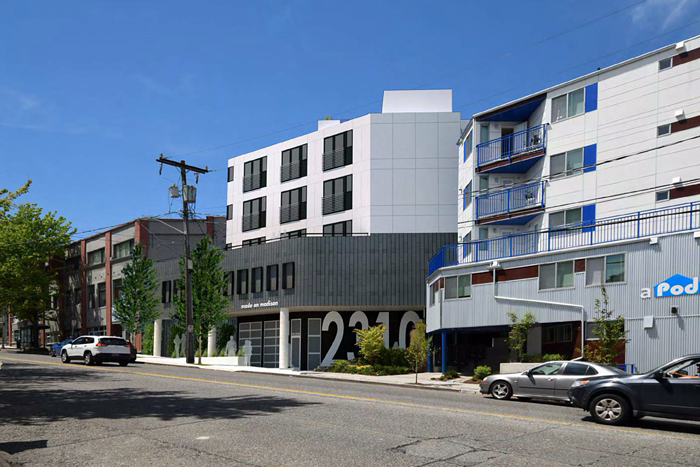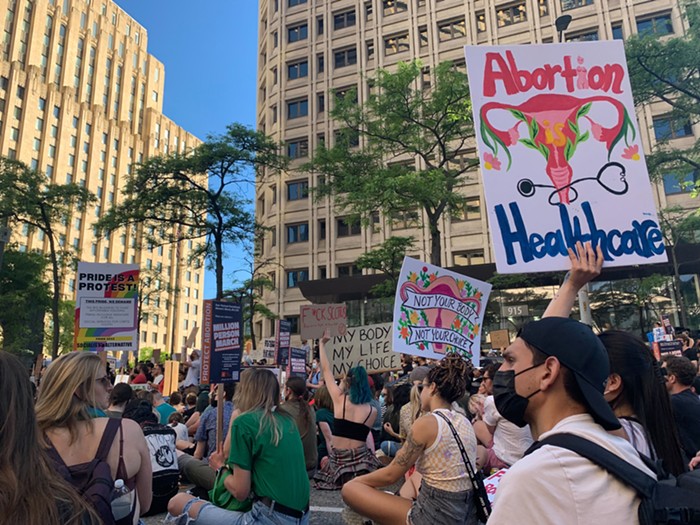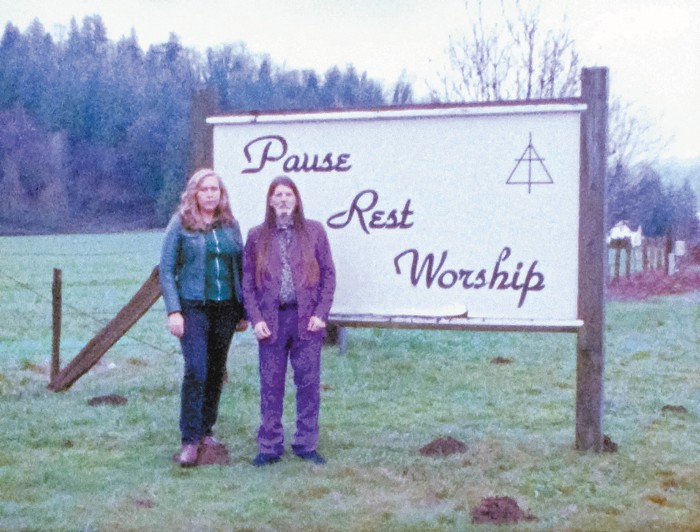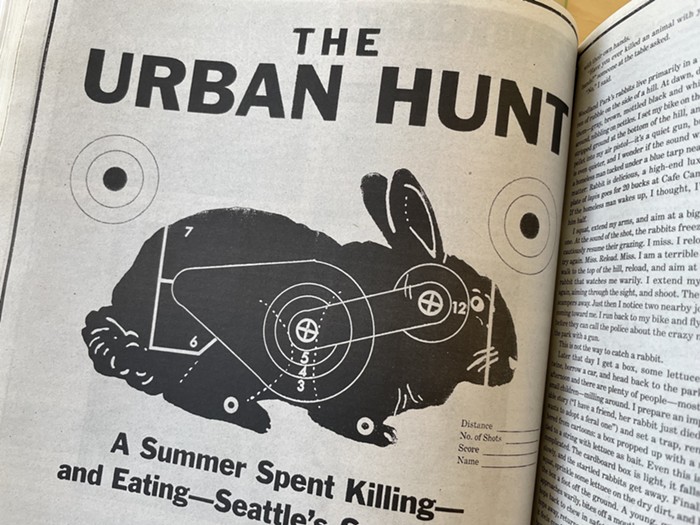Local media fashioned a compelling morality play out of the killing, first focusing on Andrews, the stricken family man, and then the skateboarder, a young and pierced tattoo artist fresh from New York. The narrative went something like this: pillar of community struck down by rootless vagabond in urban wasteland. Folded into the plot were two well-worn symbols of derision: the Ave and a skateboard.
The Ave, long considered a sort of holding pen for the habitually criminal and disaffected, has suffered from bad press for years, peaking whenever a national chain closes up shop there. When longtime tenant Porter and Jensen Jewelers announced it was vacating its Ave storefront to focus on its University Village outlet shortly after Andrews' murder, local pundits linked the two events and began wringing their hands.
A Seattle Times reporter quoted the owner of a University District business as saying he was afraid to bring his children to the Ave after dark. In a Seattle Times guest column, Ave business owner Mary Ann Kae intoned, "Lawlessness and decrepit civil behavior have taken over the neighborhood.... The public is afraid to walk the streets." In a companion guest column, hardly a "counterpoint," Taso G. Lagos opined, "Clearly something has to be done." (Nicole Brodeur, the Times columnist, did step in at the height of the hysteria and point out that she could walk the Ave, after 8:00 p.m. no less, without incurring any harm.) That the weapon in this particular homicide was a skateboard was not lost on the media either. Coupling skateboarding and violence became a new hobby for writers of headlines. "Murder charge in skateboard slaying" and "Arrests made in skateboard attack" were two examples. The association of the sport with the crime was irresistible.
Lost in the sensationalism and editorializing was the chance that this killing, awful as it was, had little to do with skateboarding or the Ave. The killing of Demetri Andrews could have happened anywhere in Seattle where a variety of people cross paths: downtown, a Mariners game, Seattle Center. In fact, of the 25 documented homicides in 2001, only five were in the North Precinct, which includes the Ave; none were on the Ave itself. Of the 26 documented homicides in 2002, only one, Andrews' killing, was in the University District. An outbreak of Ave skateboard killings this was not. Regardless, the murder of Demetri Andrews allowed those who would bemoan the Ave to sound a powerful refrain of disgust--a refrain that rested on a public perception of skateboarding that is at least a decade behind the reality in Seattle's skateboarding scene.
To begin the reality check its important to start with April 9 when Demetri Andrews crossed paths with Timothy Strano. It was on that night last Spring that Andrews and his girlfried Ageliki Barberopoulou were returnig to her UDistrict apartment from Renton after visitig a friend. Andrews had been seeig Barberopoulou for a few years since his divorce in 1999. The divorce had been a major setback in Andrews' life he'd put on a little weight and let his construction business slide. Recently he'd been spending more time doing odd jobs at his family's restaurant Niko's Place, a Greek restaurant near KeyArena that had been a hub for Seattle's Greek community since Andrews' father opened it in the 60s. Andrews himself had grown up in the restaurant busing tables fixing shelves and parking cars. He was living on Mercer Island near his brother and mother and spending time with his six-year-old son Niko. Things with Barberopoulou were going well. There was talk of an engagement.
That Tuesday night, Andrews and Barberopoulou were heading south on University Way NE above NE 45th Street, where the district's two busiest streets bisect, when two men, Timothy Strano and Joseph Tremato, skateboarded out into the street and cut Andrews off. Andrews laid on the horn; words were exchanged. Andrews, who is described by his family as peaceful, a teddy bear by nature, but expressive in a "European fashion," got out of his car.
According to Barberopoulou, Tremato and Andrews were face to face and Tremato said, "What the fuck do you want? Are you going to fucking hit me now?" The two men scuffled. Even though Andrews was larger than Tremato, it was Tremato who pushed Andrews to the ground. Oddly, Strano claims it was at this point he felt concerned for his friend's safety. So while Andrews tried to steady himself, Strano came from behind and trucked him with "all his might" in the back of the head. (To "truck" someone is to strike the person with one of the metal trucks on the underside of a skateboard.)
Strano later told police he hit Andrews at a bad angle. After Andrews fell Strano, Tremato, and Strano's brother George who had been following behind, all took off. Strano unaware of the extent of Andrews' injuries, bought a bottle of whiskey went home and got piss drunk.
That night at Harborview Medical Center Andrews seemed to be doing fine. The police incident report listed his injuries as "a cut to his head and possible cocussion." His brother who had rushed to the hospital left him for the night confident in a full recovery. However the next morning Wednesday the 10th the family was told he had slipped into a coma. Two days later a day before his 34th birthday Demetri Andrews died. Strano was arrested in a UDistrict apartment at 1:00 A.M. on April 13 after some simple detective work tracked him down.
* * *
When I went to King County Jail during visiting hours last spring, I was familiar with the portrait the prosecutor and police had painted of Strano: vagabond, drifter, resident of the dark underbelly of society. (In asking for bail of $750,000, prosecutors argued that Strano was likely to jump town because he "has few local ties" and lived a "rootless and itinerant life.") As I waited for the elevator, it seemed as if that portrait of Strano had some merit. Strano is allowed just three hours of visitation a week; he had a brother and several friends in town, but no one was there to see him. Strano's friend Tremato, who was arrested on the 13th with Strano and since released, and Strano's brother, George, did not respond when I attempted to track them down. The public defender appointed to Strano hadn¹t returned calls for over a week. No one seemed to want to talk about him-and I appeared to be the only one who wanted to talk to him.
Sitting on the other side of the thick glass, he certainly didn't look like a killer. In fact he was docile, if a bit guarded, throughout our entire conversation. He did not erupt into laughter, like the two men two stalls to my left, or fly into a rage, like the young man directly to my right, who kept slamming the glass with his fist. Strano's movements were limited to shifting his small frame between two positions: hunched over the scratchy phone or leaning back in his cage, feet on the desk in front of him.
Strano was not expecting my visit. If he was disappointed about talking to a reporter instead of friend, he did not let on. After he claimed he couldn't really talk about the case (a rule he violated several times during our conversation), he started right in on his victimhood. Oddly, his most pressing concern was not that he'd killed someone and had confessed as much to the police; that was only peripheral. The man with tattoos poking out wherever his clothing ended and two wide holes in each ear where heavy jewelry had been removed was more concerned with his image.
"I'm not such a bad guy," he said. The media, he said, made him "sound horrible."
Coming from an admitted killer behind thick glass, that's a hard statement to swallow, but it's not entirely false. While Strano was not raised on violence, his family life was no cakewalk: After following his father around to different blue-collar jobs, his family moved to a New Jersey suburb; they eventually settled in South Carolina. On my first visit, he didn't have any harsh words for his parents, but on a later visit he was more forthcoming. Strano told me his mother had "disappeared" during his nine months in jail; and that she had not been there for him his whole life, due to her own problems. His father, who he talks with regularly, works at a trash recycling center.
After high school, Strano came out to the Northwest, drawn by stories of big money on fishing boats in Alaska. That job failed to materialize and he ended up working as a handyman in Kent for most of 2000, where he lived under the roof of his employers, Mark Webber and Rochelle Madrigal.
Madrigal, owner of the Madrigal Inn, a bed and breakfast, and Traxx, a gay bar in Kent, told me Tim fed chickens, tended the cows, and was generally "a very nice young man." She had picked his older brother, George, for the bad seed.
Strano eventually moved to the U-District, where he lived on Eighth Avenue NE in a large home converted to apartments, just a half mile from the intersection of NE 45th and the Ave. It seems logical to conclude that Strano was just another Ave rat, the term used for the variety of semi-homeless residents of the Ave. But Strano, by his own account, hates the Ave and the people who hang out on it.
"I don¹t like that I'm caught up with the kids up on the Ave," he said. "Those kids bother me. I don't have any respect for them." An informal canvass of Ave rats turned up no one who knew Strano.
At Lake Union Sea Ray, where Strano worked in the service department in the months before the attack, his boss at first seemed eager to talk, but then declined to return my calls. Strano's friends who were willing to talk to me, it turned out, were all to be found in Capitol Hill's tattoo and piercing shops.
"Tim's the goofiest kid I know," said one. "It wasn't no crazy kids on the Ave with skateboards trying to beat somebody up, bro."
During my time with Strano at King County Jail, he talked mostly about tattoo art and brought out several sketches, pressing them against the glass. One showed a whole chicken, plucked and beheaded, wearing a sombrero and armed with two six-shooters. Another was of a hypodermic needle piercing a monstrous, genetically engineered cow. To my untrained eye the sketches were hardly groundbreaking, not anything I'd want on my chest, but according to Justin, one of Strano's friends who works at Superstar Tattoo on Capitol Hill, Strano is "sick with that shit."
As Strano told it, the real tragedy in this true-crime drama was that his ascent in the world of Seattle body art had been delayed, perhaps ruined. "Everything was going so good and then this shit happens," Strano said. "I don't believe it."
When I asked him about the night he killed Demetri Andrews, he balked. Oddly, after months in jail, Strano didn't give the impression he had spent much time mulling over his crime. He admitted he hadn't quite come to terms with the fact that a man was dead, but he also was quick to stick by his argument of self-defense. He described the blow from behind with a skateboard as more a matter of survival than an act of cowardice.
"The guy was a freakin' gorilla. I was shivering," he said. "The dude was like-" Strano paused to set the phone down and spread his arms wide in the glass cell.
* * *
When I first met Demetri Andrews' brother, Vasili, he had just come from one of the first meetings of Seattleites Against a Violent Environment (SAVE), an organization he was starting. After losing his brother to violence and watching the story play out in the media, Vasili, 28, had an entirely appropriate response: He got real angry. But he took that a step further, writing letters to city and University of Washington officials, and, eventually, bringing together a group of friends to form SAVE.
Sitting at a pub on the Ave, Vasili, thick-shouldered like his brother but taller and slimmer, emptied a folder of papers on the table, including a SAVE flier and copies of letters to Mayor Greg Nickels and Police Chief Gil Kerlikowske. On one of them was the stated goal of his fledgling organization: "Demand IMMEDIATE ACTION to make our neighborhoods safe." One place the city might start, said Vasili, was skateboards.
"I just think there is a component in skateboarding that is just disrespectful to the community," Vasili said. "It's loud, it causes damage; there's sort of a very flip attitude that seems to be emitted by people who are on skateboards, which I don't care for. I don't care for a defiant attitude. I think it's just part of the problem."
One of the unintended consequences of Strano's actions on April 9-besides Demetri Andrews' death-is that other Seattle skateboarders have to live with the negative image it created. Said one local skateboarder, Brandon Oreilly, 16, while practicing at Rain City Skate Park: "I think that everyone who thought skateboarders were punks before, they didn't have much of a reason other than we scuffed up some ledges. Now, it's like, he killed a guy, you know-of course it's going to give us a real bad name."
As for Strano, he is a poor representative for Seattle skaters. He didn't even know about 35th North, the only skateboarding shop on the Ave. Justin, his tattoo shop friend, said, "Tim's not even that good, you know? I don't think he considers himself a skateboarder." (Strano may disagree. On my visit with him he raised his leg up and pulled up his pants to reveal a four-inch tattoo of a skateboard. He said he had tried to quit the sport, but couldn't: He "loves skateboarding.") Ultimately, Strano falls into that category of skateboarders who use the sport mainly as a means of transportation and-unlike the 16-year-old Oreilly, who takes the bus to Rain City every day-don't devote any real energy to it.
Seattle's real skateboarding scene is not violent or anti-establishment, but as corporate and tame as any other "extreme sport." Nationally, skateboard culture supports a handful of slick magazines and its own brands of designer clothing. Skateboarding was the second fastest growing sport in the country in 2000, behind only snowboarding, according to a national sporting-goods association. Not that skateboarding has not had a mixed past: Many skate videos still glorify vandalism and violence. But with over 9.6 million potential customers, the current tally for skateboarders, the former pariah street sport is now big money.
Perhaps skateboarding's greatest icon, Tony Hawk, is a case in point. Hawk is more Michael Jordan than Allen Iverson. The family-friendly Nickelodeon network gave Hawk its Kid's Choice Award for Best Male Athlete and Best Video Game (Tony Hawk¹s Pro Skater). He¹s featured in ad campaigns for such mainstream clients as GAP, Mountain Dew, Coca-Cola, AT&T, and Gatorade; Hawk even donned a milk mustache for the "Got Milk?" ad series. Oh, and he's happily married with three kids.
To get to the heart of corporate skate culture, I checked out last summer's Sound and the Fury skate show at Sand Point. A marketer's dream, the show was part shopping emporium and part sporting event, a two-day circus at the shores of Lake Washington inside a massive hangar filled with an appealing demographic of mostly young, mostly white males. Inside the hangar, the belly of the beast of commercial skateboarding, the association of skateboarding with violent crime felt absurdly behind the times, like checkered Vans or oversized Jams. Rows of booths were selling expensive shoes and brand-name T-shirts: commercialized counterculture, sans irony.
Not that there weren't some attendees who embraced skateboarding's more traditional bad rep. Aaron Miles, a 20-year-old hanging outside the show, was convinced it was his key to getting laid. "I think it's cool [that skateboarding is] associated with violence, because it will get us more chicks. And parents will think we're, like, mad violent people and tell their daughters, 'You better not date that skateboarder.' Then girls will want to fuck us."
Miles, lounging on a ratty couch in the parking lot and obviously not getting laid, was the exception. Inside the hangar and away from the booths, in a folding chair next to a plywood ramp, I found the more likely face of the skateboarding industry.
John Falahee is 47. When I met him he was wearing the uniform du jour, which included slightly baggy pants, oversized shoes, logo T, and stiff-brimmed baseball cap, all a bit awkward-looking because he resembles Mel Brooks. Several boys, most less than half his age, hovered around him, all with similar clothing bearing the logo for ATM, the Oceanside, CA, skateboard manufacturing company that Falahee owns and operates.
Falahee flew up seven ATM team members for this year's show. He himself grew up with the sport since its infancy in the 1960s. He's seen its popularity ebb and flow, but thinks it is at its high point now, comfortably in the mainstream. He rattles off a list of places he's visited recently-California, Arizona, Detroit, Toronto-where officials are dumping money into new parks.
Last year, Seattle added a new park in Ballard, designed by skateboarders and built with city money ["Obstacle Course," Jennifer Elam, Dec 13, 2001]. It is only the second public park; the first opened permanently in October 2000 at Seattle Center. For the Ballard project the city chipped in about $60,000 despite early opposition from some community members. Washington has over 50 parks now, but still lags behind Oregon, which has one of the finest parks in the world in Newberg.
"I think the cities understand now; they're trying to help the kids out. They're giving them some place to go," Falahee said. And companies like his are making good money on selling the sport to baby boomers' kids.
"The demographics are all there," he said. "You've got parents who are skateboarders who've got kids [who skate]."
Asked if skateboarding is a crime, Falahee looked out on the crowds at the one-fifth-acre skate park, grandstands, and booths.
"It doesn't look like a crime to me," he said.
The City of Seattle agrees, mostly. Of course, there is the money for parks, and there is also no outright ban on skateboarding. But there are two 1993 city ordinances regulating skateboard use; one nixes skateboards in Westlake Park, another gives the city discretion to prohibit skateboarding in all city parks. Also, an initial 1987 city rule simply says skateboarders should travel a "reasonable" and "proper" speed and must yield the right of way to pedestrians.
Behind the skateboarding-themed expo at Sand Point was Marshall "Stack" Reid. In his 20 years in the Seattle skateboarding community, Reid has seen plenty of trends come and go. Perhaps the most embarrassing, he said, was the "gangsta phase" of the early '90s, when skateboarders' large pants got larger, and tough facades got tougher. "It was a quick passing fad that is laughed about today as the most ridiculous point in skateboarding's history," he said.
But by then, skateboarding had significant exposure in the mainstream, and the popularity and commercial success of ESPN's X Games buoyed the sport further. Reid now puts the Puget Sound skating population at 100,000.
But, said Reid, a lot of the trust between city officials and the skateboarding community could erode if people view the murder of Demetri Andrews mainly by the weapon that was used.
"Lobbyists against skate parks will [point to this] violence," he said. After all, "Who would want a bunch of skateboarders in their neighborhood if they were violent killers?"
* * *
For Strano, still in King County Jail, Christmas came early last year. A state supreme court ruling in December, stating that an assault resulting in a homicide cannot be prosecuted as murder, only manslaughter, means he's facing a lesser sentence. While a second-degree murder conviction would have meant up to 18 years in prison, he now could see as little as six years behind bars. Last month he pleaded guilty to first-degree manslaughter, avoiding a messy public trial.
But before that plea agreement (under which Strano will be paying for Andrews' medical bills and funeral), Strano received another visitor: Vasili Andrews, Demetri's bother. Lawyers for both men set up the meeting, at Vasili's request, in early December. It was held in the new Seattle Justice Center, and it was Strano's first time out of King County Jail, and his first Pepsi, since his arrest nine months ago.
Strano said his hands shook throughout the encounter. He fully expected Vasili to attack him; he had prepared himself mentally to "take the shank," or knife. But Vasili had not come for vengeance.
The two talked broadly about taking responsibility for one's actions, about the importance of accepting your mistakes. For about an hour they sought out a middle ground, which turned out to be their mutual interest in putting the horrible episode behind them.
Strano, whose own brother had not contacted him in eight months, was deeply affected by the conversation: It even influenced his decision to plead guilty.
"I thought it was really cool what the brother did," he said. "I probably admire that guy more than anyone I've ever met in my life."
Strano will be sentenced at the end of this month, and moved to a facility somewhere in the state-Monroe or Walla Walla or Spokane. There he hopes to find work creating tattoos for prisoners like himself.
Andrews' mother, Rothopi Andrews, has been vitriolic in public about the reduced sentence. But Vasili Andrews, though he won't talk about his meeting with Strano, has moved on. SAVE, the advocacy group he was cobbling together last summer, has been put on hold; Andrews is instead focusing on mending the emotional damage of his family¹s loss. To that end, the family sold Niko's Place in June. Now Vasili is trying to finish up his last two quarters at the University of Washington, and looking forward to grad school. He has made his peace with Strano, and now refers to him, almost kindly, by his first name.
"This is an event where it's best that everyone recover from it. I don't have the ability to decide what a proper punishment is, I don't have that sort of wisdom," Vasili told me. "What matters to me is that when Timothy gets out of jail he does something good with himself instead of being a destroyed human being."
* * *
As for the Ave, the city has thrown plenty of money into the neighborhood since last April. A $9 million facelift, including widened sidewalks and such aesthetic upgrades as decorative street lamps and new trash cans, is midway to completion. New businesses have moved into the neighborhood. A used bookstore has taken the place of rarely missed Porter and Jensen Jewelers; its owners report a good holiday retail season. Across the street, Tower Records has moved into the empty storefront under the ofÞces of the NPR affiliate KUOW. Two new eateries took root just a few doors away this summer.
It was outside Sureshot coffee shop at 45th and the Ave, a much-maligned corner, that Strano delivered the fatal blow to Andrews last April. Inside the Sureshot last week, I found co-owner Nikki Poirier steaming milk behind the counter.
"I think people's memories are really short, because I don't hear anybody referring to [the killing] anymore," Poirier told me. "I think most people think of it as an isolated incident."
